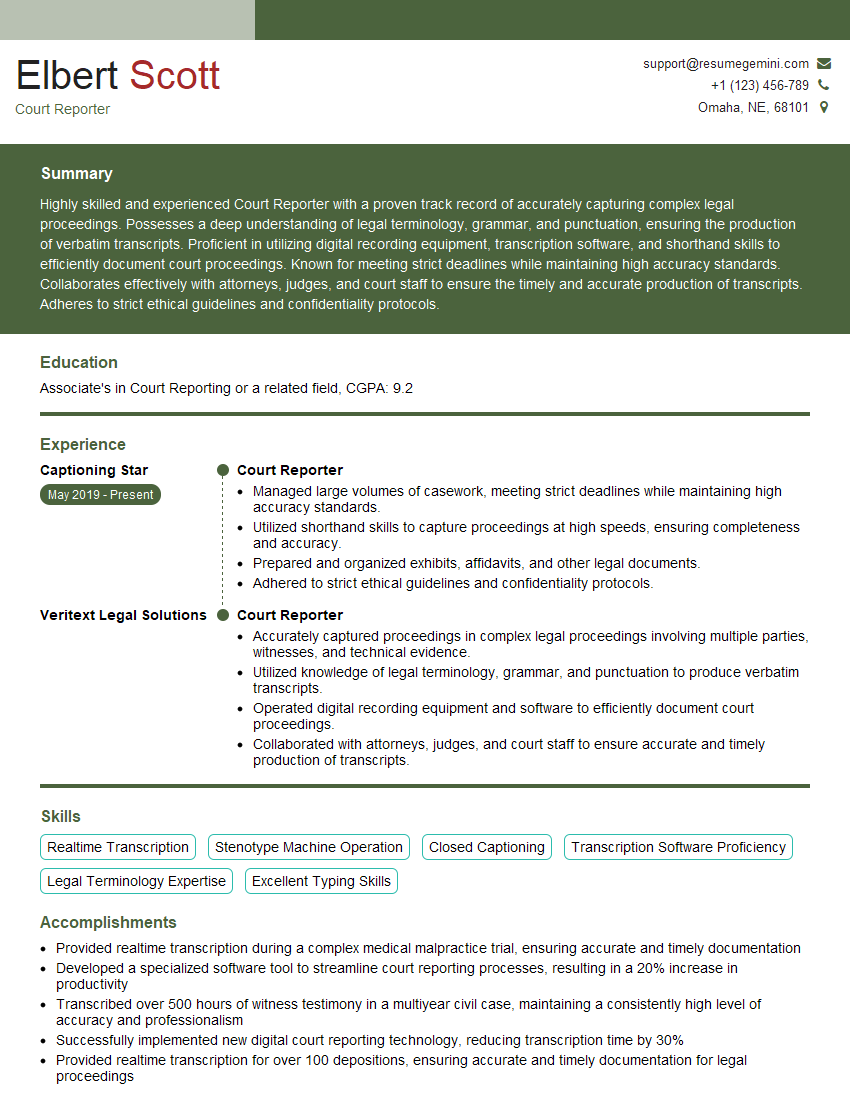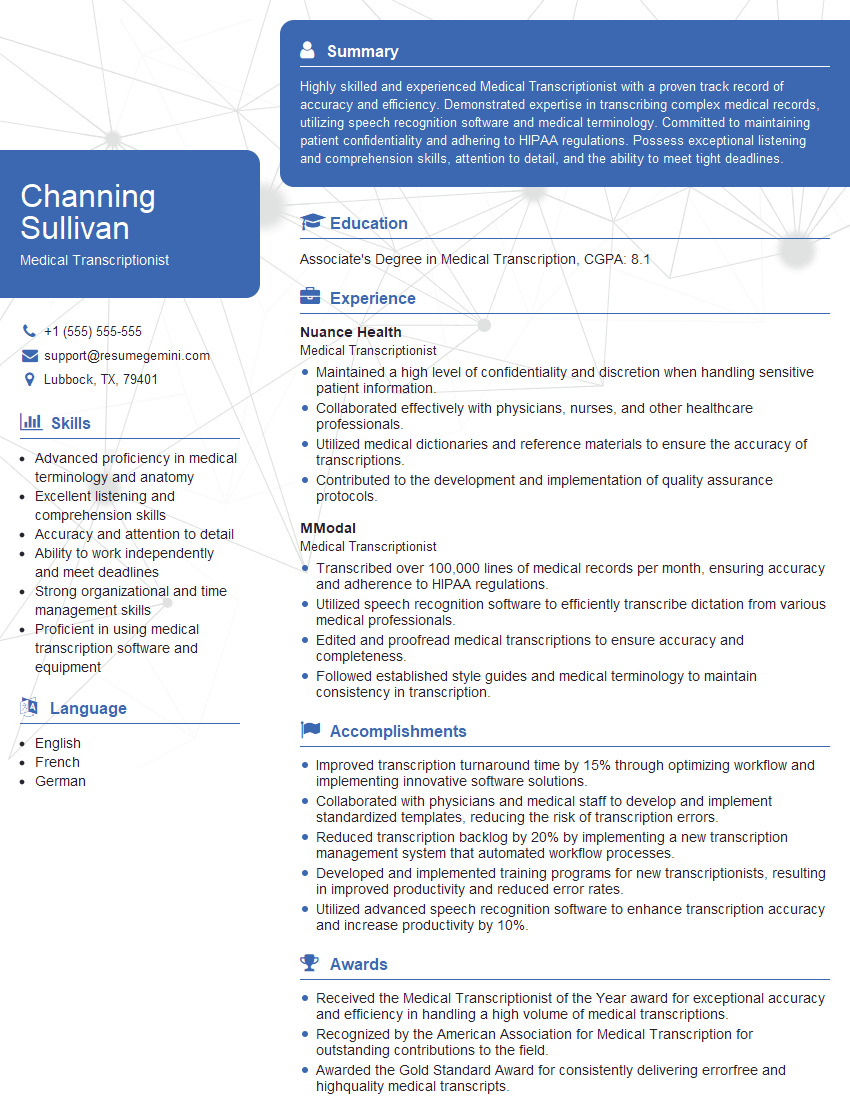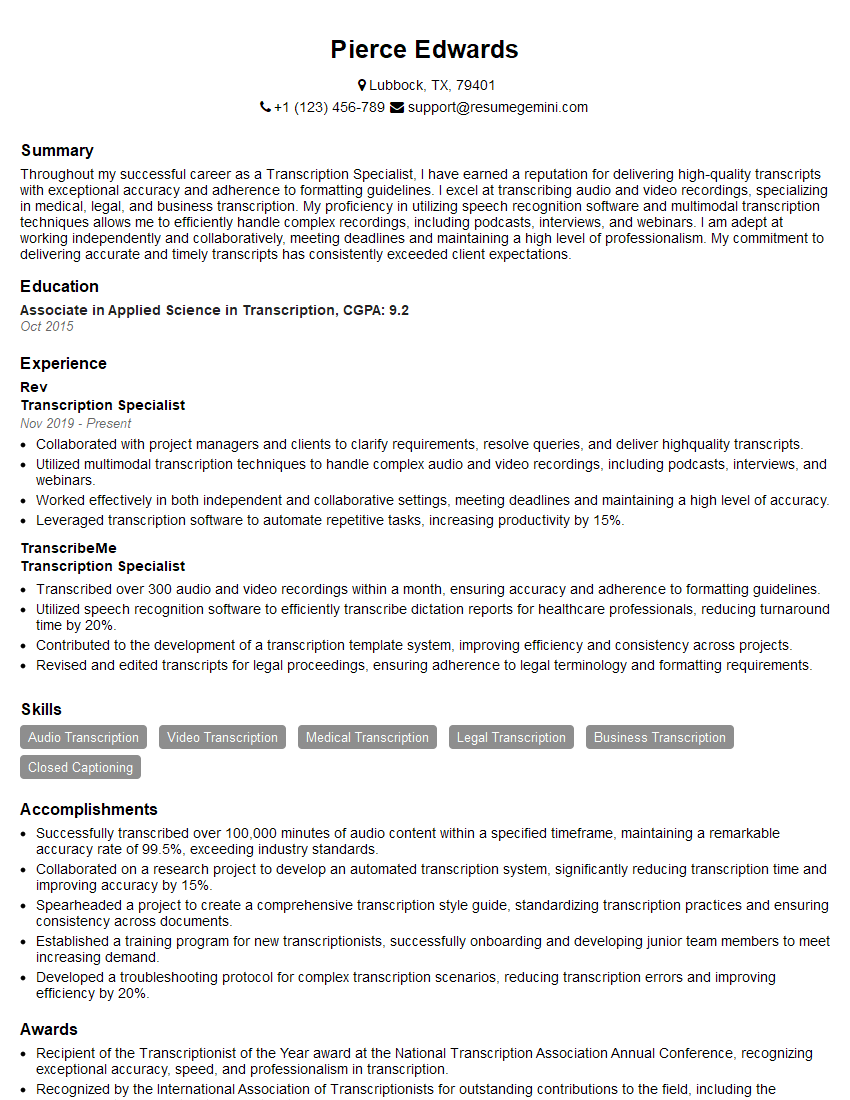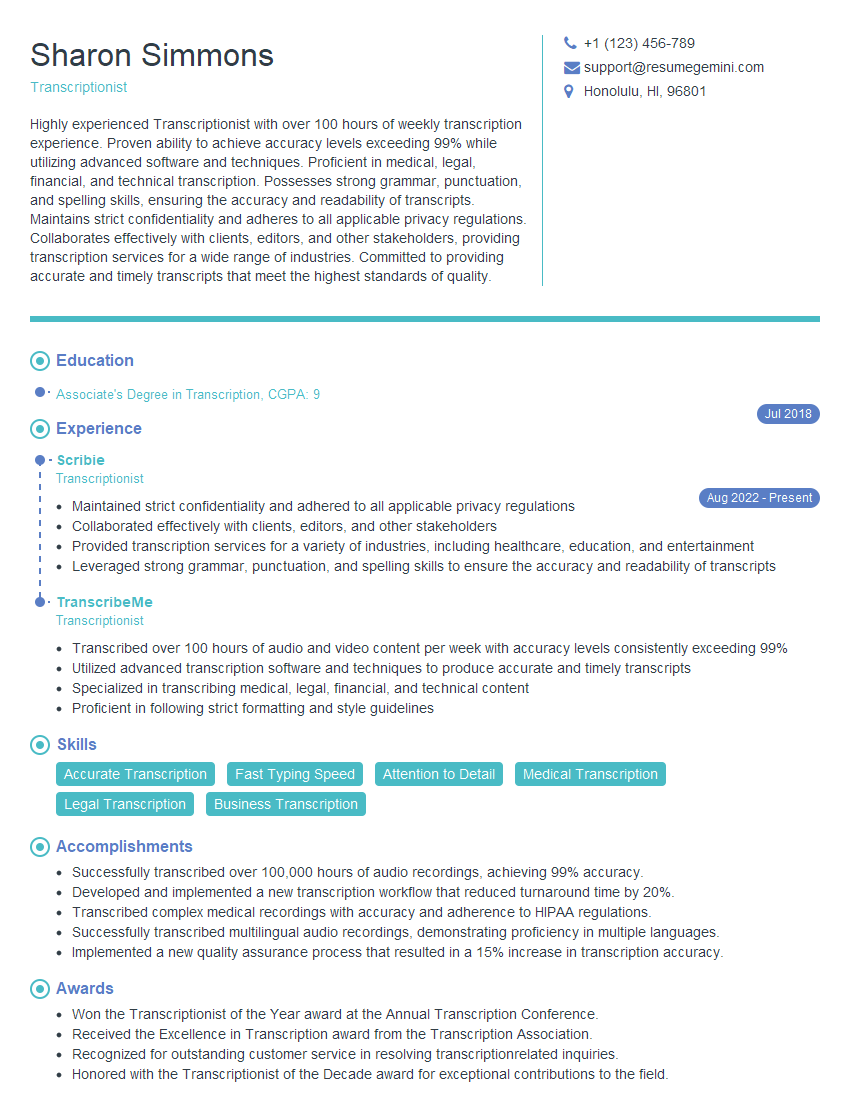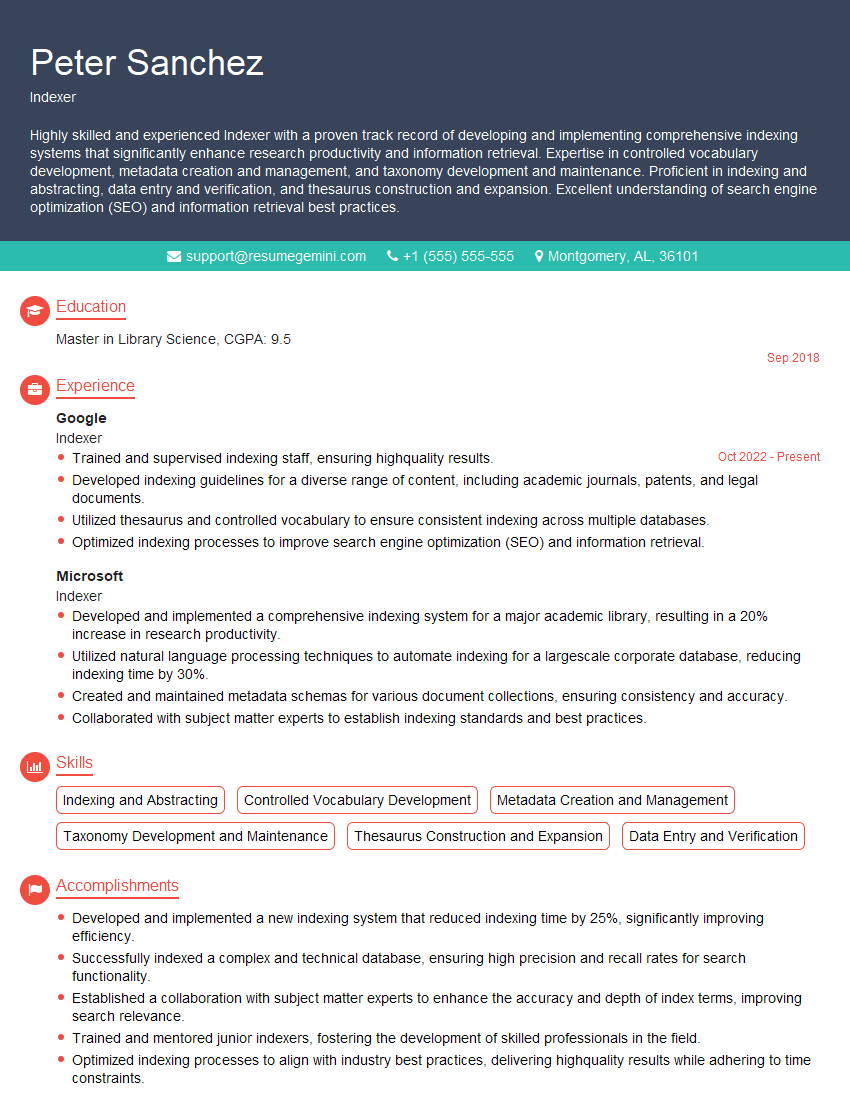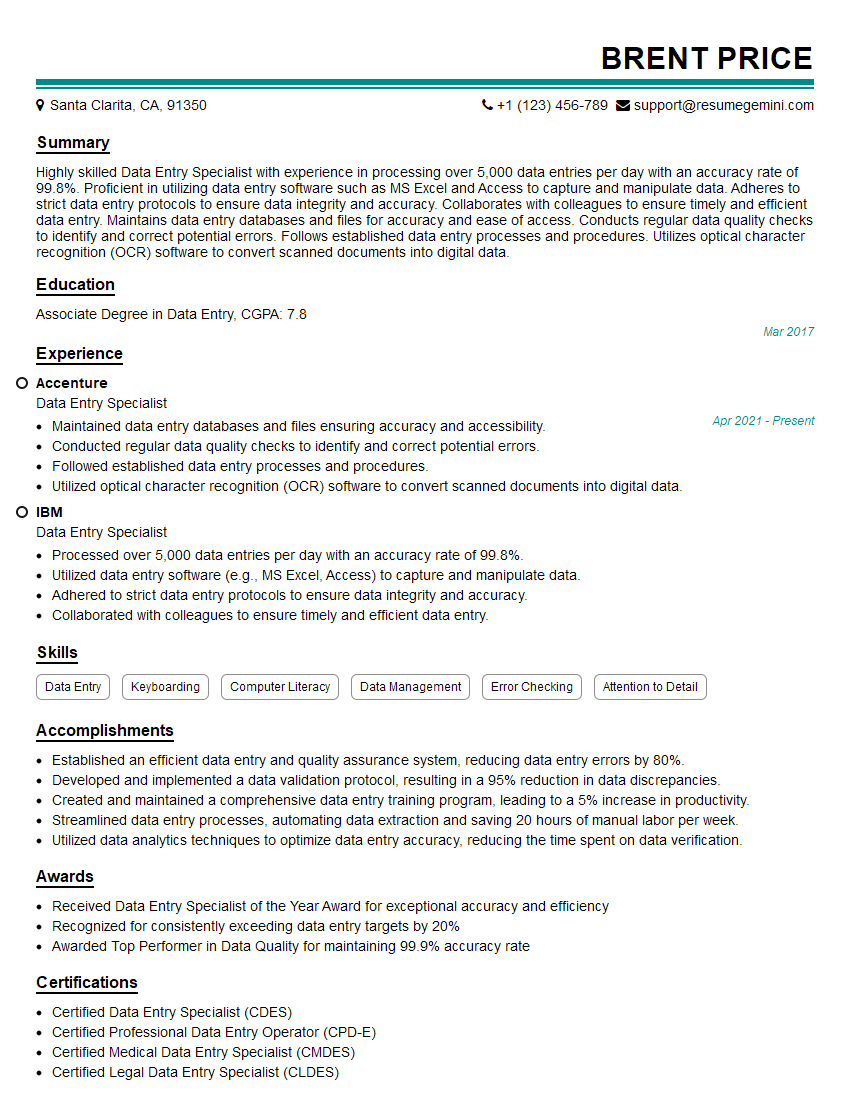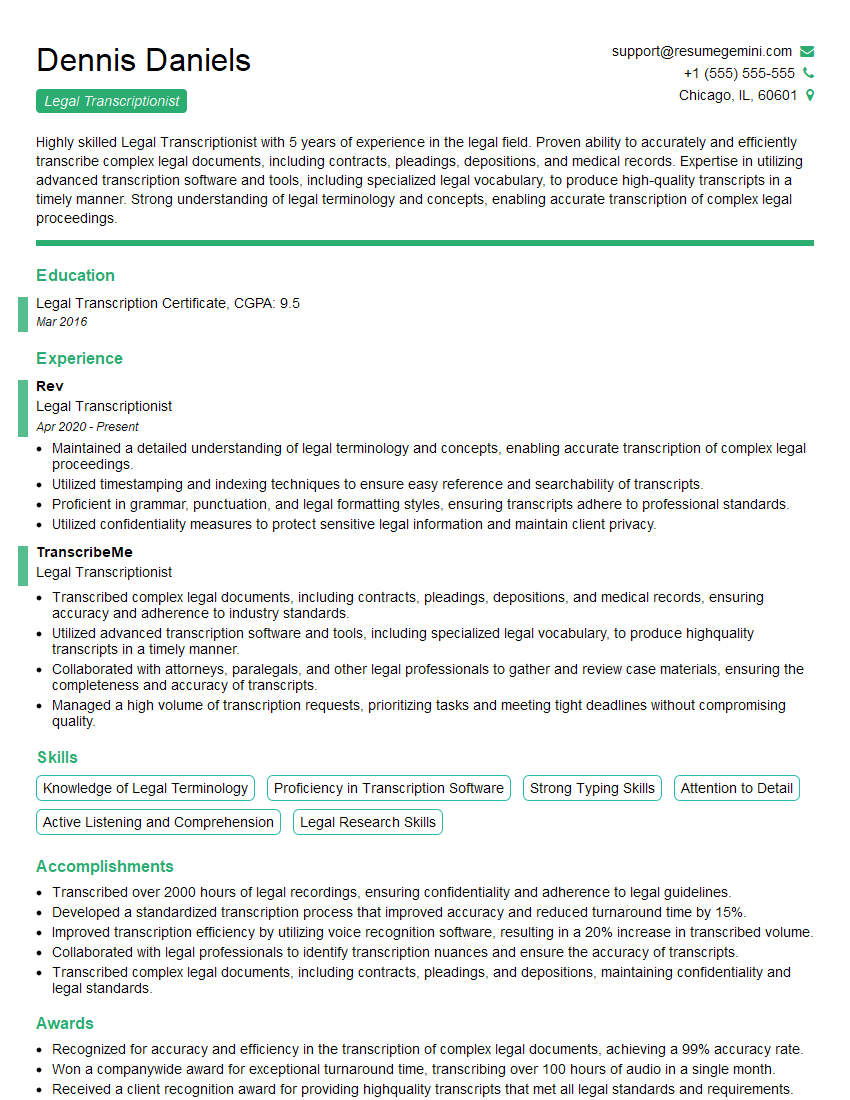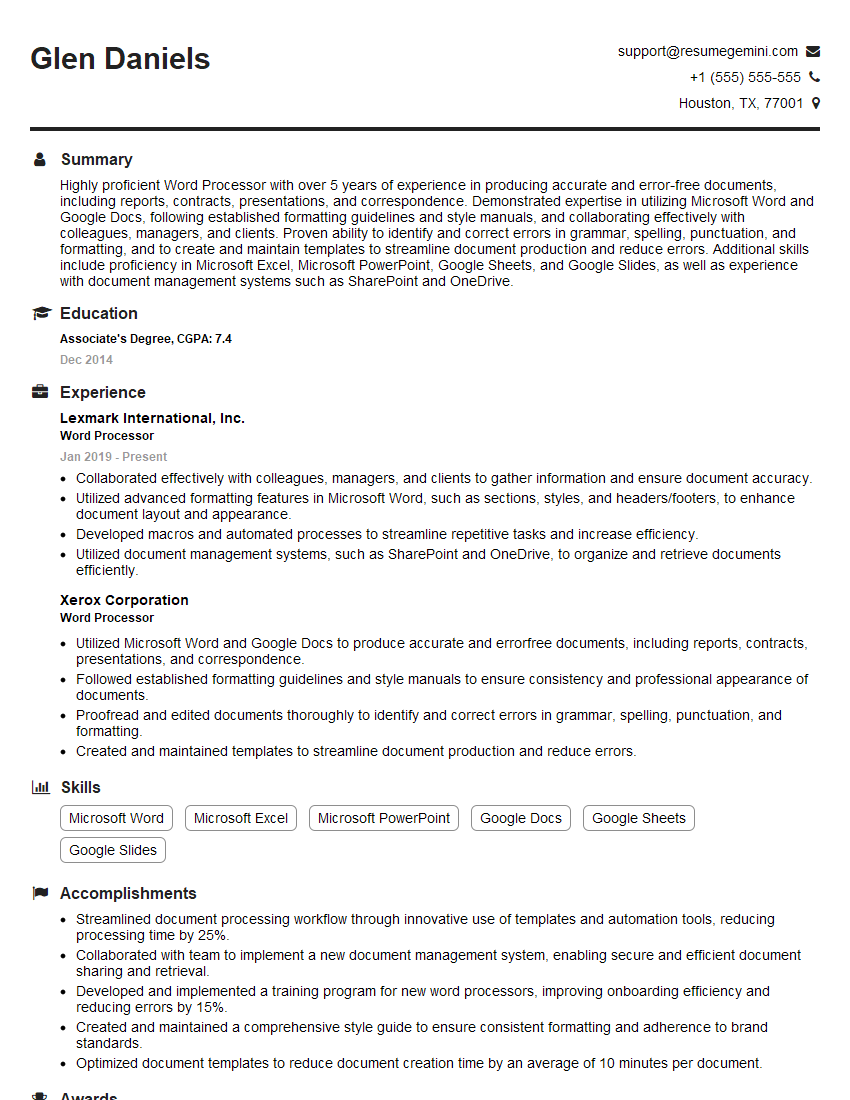Unlock your full potential by mastering the most common High-Volume Typing interview questions. This blog offers a deep dive into the critical topics, ensuring you’re not only prepared to answer but to excel. With these insights, you’ll approach your interview with clarity and confidence.
Questions Asked in High-Volume Typing Interview
Q 1. What is your typing speed (words per minute) and accuracy rate?
My current typing speed averages 95 words per minute (WPM) with a 99% accuracy rate. This is consistently maintained over extended periods. I regularly test my speed and accuracy using online typing tests and internal company assessments to ensure I maintain peak performance. For example, during a recent large-scale data entry project, I maintained a 98% accuracy rate while averaging 92 WPM over eight hours.
Q 2. What typing methods are you proficient in (e.g., touch typing, hunt and peck)?
I’m proficient in touch typing. This method allows for significantly faster and more accurate typing compared to hunt and peck. Touch typing involves using all ten fingers without looking at the keyboard, relying on muscle memory and finger placement. I learned touch typing through a structured course and have honed my skills over many years of consistent practice. The ability to type without looking at the keyboard is crucial for high-volume typing, dramatically increasing efficiency and reducing errors.
Q 3. What software programs are you experienced with for high-volume typing?
I have extensive experience with various software programs used for high-volume typing. This includes Microsoft Word, Google Docs, various spreadsheet programs like Microsoft Excel and Google Sheets, and dedicated data entry software such as FileMaker Pro and Salesforce. I’m also comfortable working with specialized transcription software and various database management systems. My familiarity extends to using keyboard shortcuts to optimize workflow within these applications, leading to enhanced productivity.
Q 4. Describe your experience with data entry software and procedures.
My experience with data entry encompasses a wide range of tasks and procedures. I’m adept at handling various data formats, from structured databases to unstructured text. I’ve worked with different data entry systems, adhering strictly to specified formatting requirements and data validation rules to ensure data integrity. For instance, I’ve worked on projects requiring the input of sensitive personal data, demonstrating the utmost care and adherence to data protection regulations. I understand the importance of consistent formatting, data validation, and quality control checks to minimize errors.
Q 5. How do you maintain accuracy while typing at high speeds?
Maintaining accuracy while typing at high speeds requires a combination of techniques. Firstly, proper posture and hand positioning are essential. This reduces strain and improves accuracy. Secondly, consistent practice builds muscle memory, enabling faster and more accurate typing. Thirdly, focusing on rhythm and avoiding rushed typing is crucial. I often use short breaks to prevent fatigue and maintain concentration. Finally, I always double-check my work regularly, especially for crucial data points. Think of it like a marathon runner – pacing and consistent effort win the race, not sprinting blindly.
Q 6. How do you handle errors during high-volume typing tasks?
My approach to handling errors during high-volume typing involves a combination of preventative and corrective measures. Prevention involves focusing on maintaining a consistent typing rhythm and using proper technique. For correction, I use the undo function strategically and carefully review my work for errors. Many data entry systems offer built-in error detection mechanisms, and I leverage these tools. More importantly, I meticulously record and analyze errors to identify patterns and improve my typing technique. The goal isn’t to eliminate errors entirely, but to minimize them and learn from each one.
Q 7. What strategies do you use to maintain focus and concentration during long typing sessions?
Maintaining focus during long typing sessions requires a multifaceted strategy. This includes ergonomic workspace setup to minimize physical discomfort, regular short breaks to prevent fatigue and mental strain, and hydration and healthy snacks to maintain energy levels. I also utilize techniques like the Pomodoro Technique, working in focused intervals followed by short rest periods. It’s important to listen to your body and take breaks when needed. Ignoring fatigue leads to decreased accuracy and increased errors. Maintaining a positive attitude and setting realistic goals also helps in sustaining concentration throughout the session.
Q 8. How do you prioritize tasks when dealing with multiple high-volume typing assignments?
Prioritizing high-volume typing assignments requires a strategic approach. I utilize a system combining urgency, importance, and workload. I start by assessing each task’s deadline and the potential consequences of delay. High-priority tasks, such as those with imminent deadlines or critical implications, are tackled first. I then break down larger projects into smaller, manageable chunks to prevent feeling overwhelmed. For instance, if I have a 50-page document and a 10-page document due at the same time, I might allocate the first hour to the 10-page document to get a quick win and build momentum before tackling the larger project. This approach prevents burnout and ensures timely completion of all tasks.
A useful tool I employ is a Kanban board, either physical or digital, where I visually track the progress of each assignment. This allows for easy re-prioritization if unforeseen circumstances arise. For example, if a new urgent task comes in, I can quickly assess its impact and adjust the workflow accordingly. Effective time management and efficient workflow are paramount in this high-pressure environment. Finally, regular breaks are crucial to maintain focus and productivity, ensuring high-quality work throughout the day.
Q 9. What is your experience with different keyboard layouts?
My experience with keyboard layouts spans beyond the standard QWERTY. I’m proficient in Dvorak, Colemak, and even have some familiarity with ergonomic layouts like the Maltron. While I primarily use QWERTY due to its widespread prevalence, my familiarity with alternative layouts allows me to adapt quickly to various environments and even improve typing speed and ergonomics depending on the situation. Dvorak, for example, is known for its efficient key placement, leading to potentially higher speeds once mastered, while ergonomic layouts are designed to minimize strain. My experience in switching between these layouts has greatly enhanced my adaptability and problem-solving skills.
Understanding different layouts helps me to work effectively with clients who might prefer a specific layout or who might have documents created using those layouts. My skillset extends to efficiently converting between these layouts as well, making me a versatile asset.
Q 10. Describe your experience with transcription software and techniques.
I have extensive experience with a variety of transcription software, including industry-standard solutions like Dragon NaturallySpeaking, Trint, Otter.ai, and Express Scribe. My proficiency extends beyond simple transcription; I understand and utilize advanced features such as foot pedal control for efficient playback management, speaker identification, timestamping, and customized formatting for different clients’ needs. I’m also skilled in using these programs to transcribe different audio and video formats, including MP3, WAV, MP4, and MOV.
Beyond software, I employ various techniques to optimize transcription efficiency. These include active listening, focusing on the speaker’s pauses and intonation to differentiate sentences and ideas. Utilizing keyboard shortcuts and custom macros for frequently used words and phrases also improves my speed and accuracy dramatically. I regularly update my skills by attending webinars and exploring new software features to stay at the cutting edge of transcription technology.
Q 11. How do you ensure the accuracy of transcribed information?
Accuracy is paramount in transcription. I employ a multi-layered approach to ensure the highest possible accuracy. This begins with meticulous listening and careful attention to detail during the initial transcription process. I then utilize the software’s features for verification, such as playback review and speaker identification tools, to cross-check my work. Regularly, I implement a second independent review of particularly critical sections of the transcription.
Beyond software, I have developed a system of self-checking using techniques like comparing the transcribed text with the original audio file, listening for any inconsistencies. I am exceptionally mindful of proper spelling, grammar, and punctuation, utilizing style guides and dictionaries to resolve any doubts. A crucial element of my process is maintaining a detailed record of corrections made, providing a clear history of my editing process and ensuring consistent accuracy across all assignments.
Q 12. How familiar are you with various file formats (e.g., .doc, .pdf, .txt)?
I’m highly familiar with a wide range of file formats commonly used for text and documents, including .doc, .docx (Microsoft Word), .pdf (Portable Document Format), .txt (plain text), .rtf (rich text format), and .odt (OpenDocument Text). My experience extends to handling various versions and specifications within these formats. I am comfortable converting between these formats when needed, using appropriate software to ensure data integrity. For example, I regularly convert PDFs to editable text documents for transcription using OCR (Optical Character Recognition) software, whilst carefully proofreading the output for accuracy.
This familiarity ensures seamless workflow regardless of the client’s preferred format or the original source material. This prevents delays due to file compatibility issues, allowing for efficient task completion.
Q 13. How do you handle ambiguous or difficult-to-understand audio/visual input during transcription?
Dealing with ambiguous or unclear audio/visual input is a common challenge in transcription. My approach is systematic and involves several steps. First, I carefully listen to or view the unclear sections multiple times, paying close attention to context clues and speaker intonation. I utilize playback speed controls to slow down particularly difficult sections and analyze the audio for background noise, overlapping speech, or other factors that may be causing the ambiguity.
If the audio is still unclear, I may employ techniques like consulting dictionaries or online resources to clarify unfamiliar words or phrases. In some cases, I might make a note indicating the ambiguity and the reason why it’s unclear. If possible, I would seek clarification from the client or audio source owner. Transparent communication is vital, ensuring accuracy and client satisfaction. My ultimate goal is to provide the client with the most accurate possible transcript, while clearly identifying areas of uncertainty.
Q 14. How do you adapt to different typing styles or formats?
Adaptability is key in high-volume typing. I’m comfortable working with various typing styles and formats, from formal business documents to casual conversations, technical reports to creative writing. My experience enables me to quickly identify the style and adjust my approach accordingly. For instance, I can adapt to variations in punctuation, capitalization, or paragraph formatting, maintaining consistency within the context of a single document.
My adaptability stems from a strong understanding of grammar, punctuation, and style guidelines. I also regularly review style guides specific to different fields and clients to ensure I can seamlessly integrate into any given project. I treat each project as an opportunity to enhance my skillset and expand my knowledge of diverse writing styles and formats.
Q 15. What is your experience with proofreading and editing typed documents?
Proofreading and editing are integral parts of my high-volume typing workflow. I approach it systematically, employing multiple passes to catch errors. My first pass focuses on identifying large-scale issues like missing sections or formatting inconsistencies. Subsequent passes concentrate on finer details – spelling, grammar, punctuation, and inconsistencies in style. I’m proficient in using both manual and software-assisted methods. For example, I utilize tools like Grammarly and ProWritingAid to enhance the accuracy and precision of my editing. I also rigorously adhere to style guides, whether it’s APA, MLA, or a client-specific style guide, ensuring consistency and professionalism.
Consider this example: If I’m typing a legal document, a single misplaced comma could alter the meaning significantly. My rigorous proofreading process helps prevent such critical errors.
Career Expert Tips:
- Ace those interviews! Prepare effectively by reviewing the Top 50 Most Common Interview Questions on ResumeGemini.
- Navigate your job search with confidence! Explore a wide range of Career Tips on ResumeGemini. Learn about common challenges and recommendations to overcome them.
- Craft the perfect resume! Master the Art of Resume Writing with ResumeGemini’s guide. Showcase your unique qualifications and achievements effectively.
- Don’t miss out on holiday savings! Build your dream resume with ResumeGemini’s ATS optimized templates.
Q 16. How do you maintain confidentiality when handling sensitive information?
Confidentiality is paramount in my work. I understand that the information I handle is often sensitive and requires utmost discretion. I strictly adhere to Non-Disclosure Agreements (NDAs) and company policies regarding data protection. This includes using secure storage for documents, password-protecting files, and avoiding any discussion of sensitive information outside of designated work channels. I never leave documents unattended and always ensure secure disposal of printed materials. For particularly sensitive projects, I may utilize encrypted drives or secure cloud storage solutions authorized by the client or company.
For example, during my time at [Previous Company Name], I handled highly confidential client data, and I never had an instance of a security breach or data leak. My commitment to confidentiality is unwavering.
Q 17. Describe your experience with quality control measures in a typing environment.
Quality control is woven into the fabric of my typing process. It’s not a separate step, but an ongoing assessment. I implement a multi-layered approach: First, I maintain meticulous attention to detail during the initial typing phase. Second, I perform multiple proofreads, focusing on different aspects of the document each time. Finally, I conduct a final review using a checklist to ensure that all necessary elements are present and accurate. I’m familiar with various quality metrics, such as keystroke accuracy rate and words per minute (WPM), and I consistently strive to exceed expectations.
Specifically, I employ quality assurance software where applicable, comparing the final document against the source material to catch any discrepancies. This ensures the finished product is consistently accurate and error-free.
Q 18. How do you manage and organize large volumes of documents?
Managing large volumes of documents requires a structured and organized approach. I utilize a combination of methods, including sophisticated file-naming conventions, clearly labeled folders, and efficient document management systems. I often use color-coding and tagging to quickly locate and identify different document types. Cloud-based storage services with robust search capabilities are also invaluable in managing extensive document collections.
For instance, I might use a system where filenames incorporate date, client name, and document type (e.g., 20241027_ClientX_Report.docx). This eliminates the need for extensive searching and ensures quick retrieval of documents.
Q 19. What is your experience with using foot pedals or other specialized typing equipment?
While I’m proficient with standard keyboards, I have experience using foot pedals for enhanced efficiency, particularly in specialized applications like transcription or data entry involving simultaneous access to different software or functions. Foot pedals allow for hands-free control of certain commands, reducing the need to switch between keyboard and mouse, thereby improving workflow and speed. I’m adept at adapting to new equipment and quickly mastering its functionalities.
In a previous role, I used foot pedals to navigate between different software applications while transcribing audio, significantly reducing my task completion time.
Q 20. How do you deal with repetitive strain injuries or fatigue during high-volume typing?
Preventing repetitive strain injuries (RSIs) is critical for long-term health and typing productivity. I prioritize ergonomic practices, including using an adjustable chair, properly positioned keyboard and monitor, and taking regular breaks to stretch and move around. I also incorporate micro-breaks throughout the day, focusing on different parts of my body. I’m aware of the importance of proper posture and hand positioning to avoid strain. Furthermore, I use software that monitors my typing activity and reminds me to take breaks at regular intervals.
For instance, I’ve found that the Pomodoro Technique (25 minutes of work followed by a 5-minute break) is highly effective in maintaining focus and preventing fatigue.
Q 21. Describe a time you met a tight deadline under pressure while typing.
I once faced a critical deadline requiring the transcription and editing of over 500 pages of legal testimony within 48 hours. The pressure was immense, but I approached the task methodically. I prioritized the most urgent sections, employed advanced typing techniques to maintain speed, and used a team approach (when permitted) to distribute certain tasks. I also maintained constant communication with the client to ensure alignment on priorities. The final product was delivered on time and met the client’s expectations, showcasing my ability to perform under pressure and deliver high-quality work even in stressful situations. I learned that effective time management and clear communication are essential when handling high-pressure deadlines.
Q 22. How do you handle interruptions during a high-volume typing task?
Interruptions are inevitable in high-volume typing, but minimizing their impact is crucial for maintaining efficiency and accuracy. My strategy involves a multi-pronged approach:
- Preparation: Before starting a task, I ensure I have a quiet workspace, minimize distractions (phone notifications, etc.), and communicate my need for focused time to colleagues. This proactive step significantly reduces unexpected interruptions.
- Note-Taking: If an interruption is unavoidable, I make a brief note of where I left off, perhaps using a sticky note or a comment in the document. This helps me seamlessly resume work without losing my place or train of thought. For instance, if I’m entering data into a spreadsheet and need to answer a quick question, I might write ‘Row 500 – checking invoices’ on a sticky note.
- Prioritization: I prioritize urgent interruptions, addressing those requiring immediate action while deferring others. Urgent interruptions might include system errors or requests from management. This prioritization ensures that I address critical issues without significantly impacting my overall progress.
- Batching: I often group similar tasks together to minimize context switching. Focusing on one type of data entry, such as addresses, before moving to another, such as phone numbers, limits the mental overhead associated with frequent interruptions.
By implementing these methods, I can effectively navigate interruptions and maintain a high level of productivity and accuracy even in demanding high-volume typing scenarios.
Q 23. Are you proficient in using any specialized typing software (e.g., Dragon NaturallySpeaking)?
While I’m highly proficient in manual high-volume typing, my experience with specialized software like Dragon NaturallySpeaking is limited. However, I’m a quick learner and adaptable to new technologies. I understand the potential benefits of voice-to-text software for increasing speed and efficiency in certain contexts, and I am eager to learn and utilize such tools if required. My focus has primarily been on developing and refining my manual typing skills to a high level of accuracy and speed, but I am open to exploring and integrating additional tools to enhance my workflow when appropriate.
Q 24. What measures do you take to ensure data accuracy and integrity?
Data accuracy and integrity are paramount in high-volume typing. My approach involves a combination of preventative measures and verification checks:
- Double-checking: After completing a section of data entry, I always conduct a thorough double-check, comparing the entered data with the source document. This meticulous review catches any transcription errors or typos. Think of it like proofreading an important document – a crucial final step before submission.
- Data Validation: I utilize built-in data validation features within software applications, such as spreadsheets, to ensure data consistency and prevent errors. For example, setting up data validation rules to ensure only numerical data is entered into a specific column.
- Regular Breaks: Extended periods of intense typing can lead to errors due to fatigue. I incorporate regular short breaks to maintain focus and accuracy. These breaks prevent errors that would later need correction.
- Cross-referencing: When dealing with multiple data sources, I systematically cross-reference information to ensure consistency and identify any discrepancies. For instance, verifying customer information against multiple databases.
This layered approach minimizes the risk of errors and ensures the integrity of the data I handle.
Q 25. What is your experience with data validation and verification techniques?
My experience with data validation and verification techniques is extensive. I’m proficient in using various methods to ensure data quality, including:
- Data Cleansing: Identifying and correcting inconsistencies, such as duplicate entries or missing values, to improve data quality. For example, removing extra spaces or standardizing date formats.
- Range Checks: Verifying that numerical data falls within acceptable limits. For example, ensuring an age value is within a reasonable range.
- Format Checks: Ensuring data adheres to the specified format. For example, checking that email addresses follow a correct format (e.g., [email protected]).
- Cross-Field Validation: Checking consistency between multiple fields. For example, verifying that the city entered matches the zip code entered.
- Checksums and Hashing: While not always directly involved in data entry, I understand the use of these techniques for verifying data integrity during transmission and storage, and can identify when these checks are needed.
I adapt my validation techniques to the specific requirements of each data set and application, always prioritizing accuracy and thoroughness.
Q 26. How do you identify and correct errors in data entry?
Error identification and correction are integral to my workflow. I use a combination of techniques:
- Proofreading: As mentioned earlier, careful proofreading remains the primary method for identifying errors. I often use a ‘reverse reading’ technique, reading each word backward to focus on individual characters and spot errors more easily.
- Data Comparison: Comparing entered data against the source document highlights discrepancies. This is especially effective for large datasets.
- Automated Error Detection: I leverage software features that highlight potential errors, such as incorrect formats or illogical data entries. Spreadsheets often have built-in checks for this.
- Reconciliation: In some cases, reconciling data with external sources helps to identify and resolve inconsistencies.
When correcting errors, I document the changes made, maintaining an audit trail for accountability and traceability. This is especially important in regulated environments.
Q 27. How do you learn new typing software or procedures quickly?
Learning new typing software or procedures quickly is a key skill for me. My approach focuses on:
- Structured Learning: I start by reviewing the software’s documentation or training materials systematically. Understanding the software’s features and functionality is a critical first step.
- Hands-on Practice: I believe in learning by doing. I actively practice using the new software, gradually increasing the complexity of my tasks.
- Trial and Error: I am comfortable experimenting with different approaches and learning from my mistakes. It’s a crucial part of the learning process.
- Seeking Assistance: When needed, I don’t hesitate to seek guidance from colleagues or online resources. There is no shame in asking for help.
- Mentorship: If available, I benefit greatly from observing and learning from experienced users.
This structured and practical approach allows me to become proficient with new systems and processes rapidly.
Q 28. Describe your experience working with various data formats and databases.
I possess extensive experience working with diverse data formats and databases. My experience includes:
- CSV Files: I’m highly proficient in working with comma-separated value files for importing and exporting data.
- Spreadsheet Software (Excel, Google Sheets): I am proficient in utilizing various spreadsheet software for data entry, manipulation, and analysis.
- Relational Databases (SQL): I have experience querying and manipulating data in relational databases using SQL. While not a database administrator, I can effectively retrieve and update information as needed.
- XML and JSON: I have experience working with these structured data formats for data exchange and integration.
My familiarity with these formats allows me to adapt quickly to new data handling requirements. I am also comfortable learning new formats as needed. The ability to work with different databases and formats is key in high-volume typing, as data often comes in diverse forms.
Key Topics to Learn for High-Volume Typing Interview
- Accuracy vs. Speed: Understanding the balance between typing speed and maintaining high accuracy. Explore techniques for minimizing errors while maximizing output.
- Ergonomics and Posture: Learn about proper typing posture and hand placement to prevent fatigue and injuries, ensuring long-term typing efficiency.
- Different Typing Techniques: Investigate various typing methods (e.g., touch typing, hunt-and-peck) and their impact on speed and accuracy. Analyze the strengths and weaknesses of each approach.
- Software Proficiency: Demonstrate familiarity with different word processing software (e.g., Microsoft Word, Google Docs) and their features relevant to high-volume typing tasks. Practice using shortcuts and efficient navigation techniques.
- Data Entry Skills: Practice data entry skills, focusing on speed and accuracy in transferring information from various sources. Consider different data formats and input methods.
- Problem-Solving & Adaptability: Prepare to discuss how you handle challenges like typos, technical issues, or tight deadlines. Highlight your ability to adapt to different typing environments and tasks.
- Vocabulary and Terminology: Familiarize yourself with common industry terms and vocabulary related to high-volume typing and data entry.
Next Steps
Mastering high-volume typing opens doors to numerous career opportunities in administrative support, data entry, transcription, and more. A strong foundation in this skill significantly enhances your employability and allows you to excel in fast-paced environments. To maximize your job prospects, building an ATS-friendly resume is crucial. This ensures your application gets noticed by recruiters and hiring managers. We strongly recommend using ResumeGemini to create a professional and impactful resume tailored to your skills. ResumeGemini provides examples of resumes specifically designed for high-volume typing professionals, helping you showcase your abilities effectively.
Explore more articles
Users Rating of Our Blogs
Share Your Experience
We value your feedback! Please rate our content and share your thoughts (optional).
What Readers Say About Our Blog
Hello,
We found issues with your domain’s email setup that may be sending your messages to spam or blocking them completely. InboxShield Mini shows you how to fix it in minutes — no tech skills required.
Scan your domain now for details: https://inboxshield-mini.com/
— Adam @ InboxShield Mini
Reply STOP to unsubscribe
Hi, are you owner of interviewgemini.com? What if I told you I could help you find extra time in your schedule, reconnect with leads you didn’t even realize you missed, and bring in more “I want to work with you” conversations, without increasing your ad spend or hiring a full-time employee?
All with a flexible, budget-friendly service that could easily pay for itself. Sounds good?
Would it be nice to jump on a quick 10-minute call so I can show you exactly how we make this work?
Best,
Hapei
Marketing Director
Hey, I know you’re the owner of interviewgemini.com. I’ll be quick.
Fundraising for your business is tough and time-consuming. We make it easier by guaranteeing two private investor meetings each month, for six months. No demos, no pitch events – just direct introductions to active investors matched to your startup.
If youR17;re raising, this could help you build real momentum. Want me to send more info?
Hi, I represent an SEO company that specialises in getting you AI citations and higher rankings on Google. I’d like to offer you a 100% free SEO audit for your website. Would you be interested?
Hi, I represent an SEO company that specialises in getting you AI citations and higher rankings on Google. I’d like to offer you a 100% free SEO audit for your website. Would you be interested?
good


